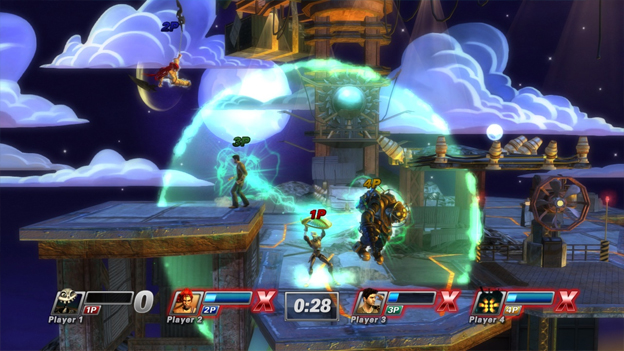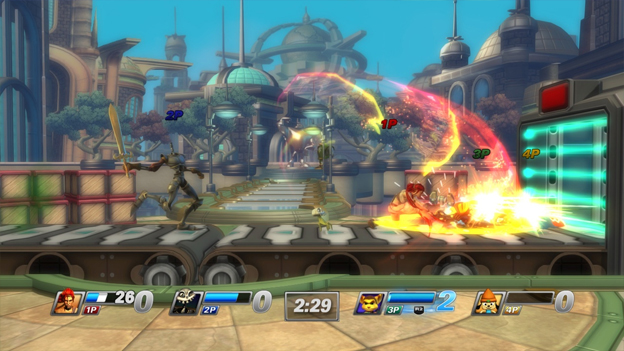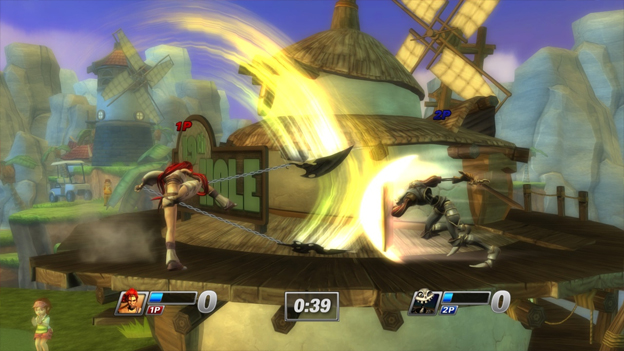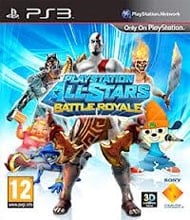The Line Between Casual And Hardcore
It’s nearly impossible to review PlayStation All-Stars Battle Royale without drawing parallels to Nintendo’s Super Smash Bros. series. So I’m not even going to try.
Super Smash was one of those one in a million series that could be appreciated by both casual and hardcore players alike. Sure, it spawned countless arguments about stage selection, item usage, and whether or not Meta Knight should be banned, but when all was said and done, casual players had a crazy flashy, button-mashy chaos-fest while pros had a deep and nuanced game that focused on positioning and evasion.

Sony PlayStation All-Stars Battle Royale attempts to recreate the magic of Smash, but in a different way. Instead of creating a game that inevitably causes arguments about what settings to use, Superbot attempts to create a game that can be enjoyed by casuals and pros on any settings. In some ways, they succeed, but in others, they actually drive an even deeper rift between the casual and hardcore crowds. PlayStation All-Stars Battle Royale is an undeniably fun game, but it is also frustrating if you are the type of person who takes your competitive games seriously.
Here’s how the game works: You have three basic attack buttons—light, heavy, and special. Like Smash, these attack buttons do different things depending on what direction you hold while pressing them. Because of the simple control scheme, certain characters actually get to retain combos from the games they come from. For example, Kratos’ basic attacks correspond to the exact buttons you would use in God of War, while Heihachi has some simple Tekken strings that use the basic Tekken button placement as well. Also, the difference from “tilts” and “smashes” that we saw in the Smash series has been removed by simply assigning light and heavy attacks to two different buttons.
The block button is a shoulder button, and it works well enough. Using it on the ground allows you to shield yourself from enemy attacks and combining it with a direction or using it in the air lets you dodge. Unlike Smash and many other fighting games, your guard can never be broken. You can be thrown out of a guard, however. (To throw your opponent, just tap the right stick in the direction you want to throw said opponent.) Unfortunately, this is the weirdest control in the game, as tapping the right stick doesn’t nearly have the accuracy or responsiveness that it needs to have for split-second throws in a fighting game.

The final button that you have to be concerned about (other than the jump button which, simply put, lets you jump) is the Super button, which is assigned to the right trigger and allows you to use your accumulated Super bar for Super attacks. This is the most important mechanic in the game. Supers are the only ways to score kills in the game; there is literally no way to die other than being hit by an opponent’s Super. That means stage hazards can’t kill you, items can’t kill you, and you can’t accidentally fall off the stage to your death. Battle Royale has essentially eliminated all of the “cheap death” scenarios that have annoyed us for ages in Smash.
But if Supers are the only thing that can kill you, what do all of your other attacks do? Well, the only thing they do is build meter. If an attack hits home it builds a lot of meter, and if it’s blocked it builds significantly less. Throwing an opponent makes him lose a portion of his meter, and getting hit by an item or a stage hazard does the same. So the only thing your normal attacks do is build meter and adjust positioning, and while this seems like a shallow premise, it actually works.

This is mostly due to the game’s fun combo system. Chaining moves together in flashy ways builds your meter faster than simply spamming attacks at your opponent. And there is an anti-infinite combo system built right into the game, as building meter past a certain point causes your opponent to automatically burst out, flying to the other side of the screen. Managing to hit this limit does reward you with another hefty meter bonus which gives you an interesting choice between trying to build the most meter possible or attempting to hit your opponent with a reset and keep your positioning. These are high-level fighting game tactics that you wouldn’t necessarily expect from a party-style fighter.
There are a few problems with the game when played in certain modes, though. Free-for-alls are extremely annoying, as the addition of a third and fourth player essentially nullifies the game’s entire combo system. You can rarely get past the second or third hit in a combo without another character attempting to stab you in the back, so most of the time you don’t even bother, resorting instead to spamming your safest meter-building attack over and over again. 1v1 is a more balanced game type, focusing more on positioning and combo execution, but it essentially makes Level 2 and Level 3 Supers, which most of the time are just boosts to area of effect, totally pointless. Timed matches can unfortunately put players in positions where there is thirty second left in a match but no way to build meter fast enough to get another Super out, which reduces the entire game to runaway tactics.
The most balanced type of match in the game is the “Kill Limit” match, which tasks players with scoring a certain number of kills, but even these can feel cheap when an opponent lands one lucky Level 3 Super in a multiplayer match which scores him seven kills at once and instantly wins him the game. On top of all this, in every game type, whiffing a Super is so detrimental that it’s nearly impossible to come back from. It essentially makes all the work you spent building the meter for that super go to waste, and several matches come down to “whoever screws up their super first loses.” So in terms of gameplay, I wouldn’t say that Superbot has necessarily hit the sweet spot that pleases both casuals and hardcores at the same time. Arguments will still be had about the “correct” match settings to use, and certain parts of the game will be ignored or turned off altogether in the pursuit of a more balanced experience.
But in terms of flavor, Superbot has made a game that everyone can enjoy. The roster is one of the best crossover rosters we have seen in a long while, rivaling Marvel vs. Capcom 3 in sheer awesomeness. Do you want to play as modern day PlayStation heroes like Kratos, Nathan Drake, or Cole from inFamous? Or perhaps you’re more of a classic gamer, choosing instead to play as Sweet Tooth, PaRappa the Rapper, or Sir Daniel Fortesque? Maybe you’d like to choose a third party hero like Heihachi from Tekken, Dante from Devil May Cry, the Big Daddy from BioShock, or Raiden from Metal Gear Rising: Revengeance. Yes, you can even play as Sackboy if you want to. There are even more characters to choose from and a whole host of new DLC characters will be joining them at a later date.

The stages of Battle Royale are also a triumph of creativity. Each stage mashes up two Sony properties, like God of War and Ratchet and Clank or LittleBigPlanet and Buzz! The stages change over the course of a match, introducing new hazards and new layouts as you play. Stage hazards only come into play a few times over the course of a match, never becoming prominent enough to make you focus on them more than your opponent. The stage list is far more balanced and much more interesting than anything you have seen out of any Smash title.
And, of course, there is online play. At time of writing, there weren’t many people on the PS All-Stars servers, but if the beta can be used as any indication, the servers will be almost constantly packed over the lifetime of the game. Battle Royale’s netcode is rollback-based, meaning that you won’t experience any button lag at all while playing online. Unfortunately, this does mean that characters will sometimes teleport around the stage and attacks will randomly become unblockable as a result of lag spikes desynching the players. It’s somewhat annoying at times, but is worth it to avoid slowdown.
It’s hard to deny that PlayStation All-Stars Battle Royale is fun, but it’s not “the golden fix” to the Smash Brothers formula that some gamers are hoping it is. It’s just another party-style fighting game that can be tweaked to be more or less random and chaotic, just like every other Smash clone before it. But unlike other Smash clones that you may have played, PlayStation All-Stars Battle Royale isn’t a quick crossover cash-in. It’s a well-thought-out game with responsive controls and a magnificent roster. It’s the first game that I can confidently say gives Smash Brothers a run for its money. However, it’s not perfect, and it certainly doesn’t hold a candle to more balanced hardcore fighters on the market like Street Fighter, BlazBlue, Tekken, or Skullgirls.
As long as you understand that, there is no reason not to give PlayStation All-Stars Battle Royale a try. It’s $60 well spent.
RATING OUT OF 5 RATING DESCRIPTION 3.7 Graphics
The graphics are barebones everywhere but in battle. Luckily, the in-game graphics make up for it. 4.2 Control
The controls work for everything except throws. The game is largely responsive and lets you string together impressive combos. 4.1 Music / Sound FX / Voice Acting
The game’s techno soundtrack and voice acting are pleasing to listen to, but they’re side-notes in the presentation. 4.3 Play Value
Overall, it’s an enjoyable game that sets itself apart from Smash Brothers in many interesting ways. 4.0 Overall Rating – Great
Not an average. See Rating legend below for a final score breakdown.
| Review Rating Legend | |||
|---|---|---|---|
| 0.1 – 1.9 = Avoid | 2.5 – 2.9 = Average | 3.5 – 3.9 = Good | 4.5 – 4.9 = Must Buy |
| 2.0 – 2.4 = Poor | 3.0 – 3.4 = Fair | 4.0 – 4.4 = Great | 5.0 = The Best |
Game Features:
